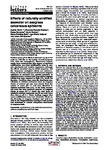Effects of naturally acidified seawater on seagrass calcareous epibionts
Date
2008-12-23Author
Subject
Metadata
Show full item recordAbstract
<jats:p> Surface ocean pH is likely to decrease by up to 0.4 units by 2100 due to the uptake of anthropogenic CO <jats:sub>2</jats:sub> from the atmosphere. Short-term experiments have revealed that this degree of seawater acidification can alter calcification rates in certain planktonic and benthic organisms, although the effects recorded may be shock responses and the long-term ecological effects are unknown. Here, we show the response of calcareous seagrass epibionts to elevated CO <jats:sub>2</jats:sub> partial pressure in aquaria and at a volcanic vent area where seagrass habitat has been exposed to high CO <jats:sub>2</jats:sub> levels for decades. Coralline algae were the dominant contributors to calcium carbonate mass on seagrass blades at normal pH but were absent from the system at mean pH 7.7 and were dissolved in aquaria enriched with CO <jats:sub>2</jats:sub> . In the field, bryozoans were the only calcifiers present on seagrass blades at mean pH 7.7 where the total mass of epiphytic calcium carbonate was 90 per cent lower than that at pH 8.2. These findings suggest that ocean acidification may have dramatic effects on the diversity of seagrass habitats and lead to a shift in the biogeochemical cycling of both carbon and carbonate in coastal ecosystems dominated by seagrass beds. </jats:p>
Collections
Publisher
Place of Publication
Journal
Volume
Issue
Pagination
Author URL
Recommended, similar items
The following license files are associated with this item:


